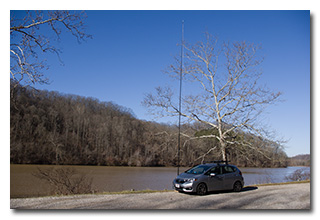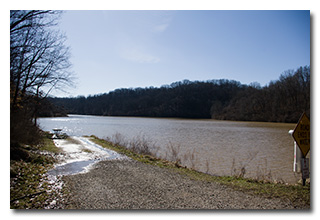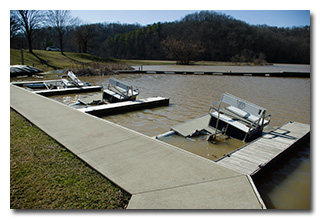
by William Eric McFadden
From the Strouds Run State Park website:
-
Strouds Run State Park is located in the scenic forested hills of Athens County, in the midst of the unglaciated Appalachian Plateau. Although untouched by the vast ice sheets that moved across portions of the state over 12,000 years ago, Strouds Run displays the effects of the glaciers -- in the deep ravines and high hills -- where the valleys served as outlets for torrents of glacial meltwaters. The erosive power of these waters carved the valleys and hillsides, creating the familiar topography Ohioans know today. Large deposits of glacial outwash, primarily sand and gravel, were deposited along these streams and strongly affected the type of biological communities present today.
Sandstone, the principal bedrock outcropping in the region, is very resistant to erosion and forms the uplands and steep sides of the valleys. Twisting roads and forest trails pass through these deep ravines and lead to dense stands of beech, hickory, oak, maple and tuliptree. Seasonal displays are offered by flowering dogwood, redbud and spring wildflowers -- with fall presenting a pageant of colorful foliage. These woods are home to white-tailed deer, fox, raccoon, opossum, squirrel, wild turkey and a variety of songbirds. Woodthrush, white-breasted nuthatch, scarlet tanager, pileated woodpecker and the rufous-sided towhee inhabit the forest canopy. These rugged hills and woodlands are truly reminiscent of the wilderness that characterized the Ohio country in the days of early settlers.
Pictures
Description
 On Saturday, February 18, 2023, one member of the Southeast Ohio Radio Adventure Team
performed a successful activation of Strouds Run State Park (K-1994) as part of the Parks on the Air
(POTA; link) program.
On Saturday, February 18, 2023, one member of the Southeast Ohio Radio Adventure Team
performed a successful activation of Strouds Run State Park (K-1994) as part of the Parks on the Air
(POTA; link) program.
Having made himself a goal of earning in 2023 the Bear Cave Repeat Offender Activator Award by performing sixty activations of the park, Eric McFadden, WD8RIF, visited the small boat-ramp near the swim-beach area at Strouds Run State Park on a cold (34°) but brilliantly-sunny mid-February morning to perform his 50th activation of the park.
Eric arrived at the small boat-ramp at around 1435 UTC, found a parking place, and deployed his 28½' wire vertical supported on his 31' Jackite telescoping fiberglass mast and drive-on base. Because of the cold temperature, Eric deployed his KX3 in the car. Eric was on the air at 1441 UTC.
As expected, Eric found he had good cell-signal at this location and would be able to spot himself on the POTA Spots website and to use POTA Spots to identify possible Park-to-Park (P2P) QSOs.
 This being ARRL DX CW Contest weekend, Eric had hoped to be able to validate this activation by making
ten DX QSOs, in hunt-and-pounce mode, on 15m. However, after spending several minutes failing to work even
the strongest stations who wouldn't respond to his QRP signal, Eric decided to switch to 20m and run a
frequency.
This being ARRL DX CW Contest weekend, Eric had hoped to be able to validate this activation by making
ten DX QSOs, in hunt-and-pounce mode, on 15m. However, after spending several minutes failing to work even
the strongest stations who wouldn't respond to his QRP signal, Eric decided to switch to 20m and run a
frequency.
Despite there being major contest underway, 20m didn't sound all that busy and Eric was able to find an open frequency near 14.060 MHz. Eric began calling "CQ POTA" and was pleased to see that he was auto-spotted in short order. Eric's first QSO came at 1449 UTC with KJ7DT in Idaho. QSOs came very quickly, with Eric's eighth QSO coming at 1457 UTC with KC2EE in Texas. At this point, contest stations began to rise out of the noise floor and Eric was forced to change frequency slightly before resuming his run. At 1459 UTC, Eric had a QSO with AB0H in Montana, and at 1501 UTC, he had a QSO with KN1R in Florida. This run of ten QSOs included QSOs with operators located in Idaho, Texas (2), Tennessee, Rhode Island, Ontario, Arizona, Florida, and Montana.
Pausing to check POTA Spots for P2P QSO opportunities, at 1506 UTC, Eric made a P2P QSO on 30m with KG8CO who was activating Malan Waterfowl National Wildlife Management Area (K-6726) in Michigan. Eric learned later that KG8CO was actually doing a four-fer activation of Malan Waterfowl National Wildlife Management Area (K-6726), Waterloo Unit State Game Land (K-6804), Waterloo State Recreation Area (K-3331), and Michigan Wetland Management District (K-0350).
Returning to 15m to again try his success at hunting DX, Eric found band conditions to be a little bit better. At 1509 UTC, he made a QSO with P44W who was running 100w in Aruba, and at 1514 UTC, he made a QSO with PJ2T who was running a kilowatt in Curacao.
Pausing again to check POTA Spots for P2P QSO opportunities, at 1521 UTC Eric made a P2P QSO on 40m with AE2T who was performing a two-fer activation of Tonawanda Wildlife Management Area (K-8100) and Erie Canalway Heritage Corridor National Park Reserve (K-6532) in New York.
Finding himself a frequency to run on 30m, Eric began calling "CQ POTA" and was again pleased to see that he was quickly auto-spotted. His first QSO in this run came at 1523 UTC with KQ4CW in Virginia. QSOs on 30m came very quickly, with Eric's nineteenth QSO in this run coming at 1540 UTC with AE2T who was still performing a two-fer activation of Tonawanda Wildlife Management Area (K-8100) and Erie Canalway Heritage Corridor National Park Reserve (K-6532) in New York.
In all, counting AE2T's two-fer and KG8CO's four-fer, Eric logged thirty-seven QSOs, including eight P2P QSOs. All of Eric's QSOs were CW and were made at five watts output.
Eric also submitted his log to the World Wide Flora and Fauna in Amateur Radio (WWFF; link) program for an operation at Strouds Run State Park, KFF-1994.
(return)
